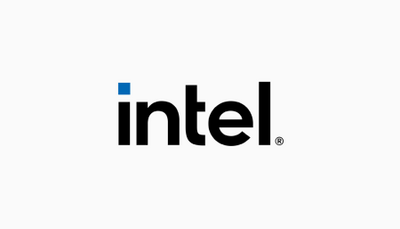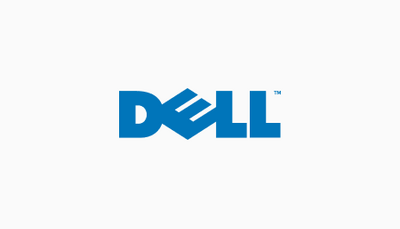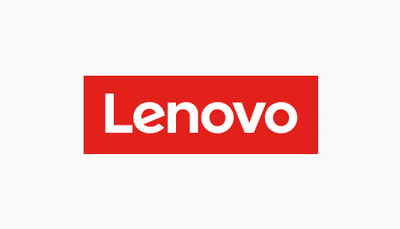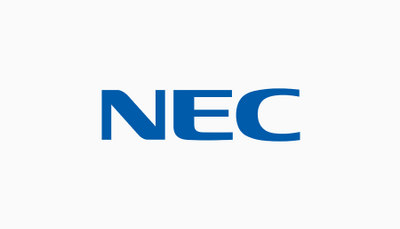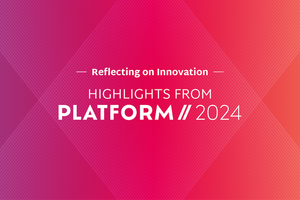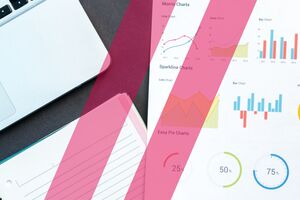
Scale Computing HyperCore™
Simplify your systems, and move beyond traditional IT silos.
Scale Computing HyperCore saves you time and valuable resources because your software, servers, and storage are in a fully integrated platform. The same innovative software and simple user interface power your infrastructure regardless of your hardware configuration.
Using patented HyperCore technology, the award-winning self-healing platform identifies, reduces, and corrects problems in real-time. Achieve results easier and faster, even when local IT resources are scarce. SC//HyperCore makes ensuring application uptime easier for IT to manage and for customers to afford.
More Efficient, Manageable, and Cost-Effective
Deploy and manage easily. With the self-healing capabilities and intelligent automation of SC//HyperCore, customers spend less time on infrastructure maintenance and focus on strategic projects to grow their business.
Eliminate the need to combine traditional virtualization software, disaster recovery software, servers, and shared storage from separate vendors to create a virtualized environment. SC//HyperCore’s lightweight, all-in-one architecture makes it easy to deploy fully integrated, highly available virtualization right out of the box.
Plan the perfect future by not predicting it. Capacity, performance requirements, and hardware specs will forever change. Legacy applications will remain mission-critical. Modern applications require new architectures. Simply mix and match the old and the new on SC//HyperCore for a future-proof environment that can scale up or down as needed.

Escape the Uncertainty of VMware/Broadcom
Save 25% or more with the industry-leading VMware alternative.
Find out why Scale Computing is the best VMware alternative. Don’t risk your infrastructure on VMware’s uncertainty. Switch to Scale Computing for a future-proof solution that eliminates the chaos and complexity.
Explore SC//HyperCore
Learn more about the features behind SC//HyperCore

SCRIBE
SCRIBE
Scale Computing Reliable Independent Block Engine is an enterprise-class, clustered, block storage layer and critical component of Scale Computing HyperCore.

HEAT
HEAT
The addition of flash storage in SC//HyperCore nodes allows more capabilities in the SCRIBE storage architecture with the HyperCore Enhanced Automated Tiering (HEAT) feature.

AIME
AIOps Engine
The Autonomous Infrastructure Management Engine (AIME) is the artificial intelligence orchestration and management functionality that powers Scale Computing HyperCore.

Hypervisor
Hypervisor
SC//HyperCore's software layer includes a lightweight, type-1 hypervisor that directly integrates into the OS kernel, leveraging virtualization offload capabilities provided by modern CPUs.

SCRIBE
SCRIBE
Scale Computing Reliable Independent Block Engine is an enterprise-class, clustered, block storage layer and critical component of Scale Computing HyperCore.

HEAT
HEAT
The addition of flash storage in SC//HyperCore nodes allows more capabilities in the SCRIBE storage architecture with the HyperCore Enhanced Automated Tiering (HEAT) feature.

AIME
AIOps Engine
The Autonomous Infrastructure Management Engine (AIME) is the artificial intelligence orchestration and management functionality that powers Scale Computing HyperCore.

Hypervisor
Hypervisor
SC//HyperCore's software layer includes a lightweight, type-1 hypervisor that directly integrates into the OS kernel, leveraging virtualization offload capabilities provided by modern CPUs.
Get Highly Available Computing Without the Complexity
Scale Computing HyperCore architecture provides scalable, accessible computing and storage while maintaining simplicity through automation and design.
Scale Computing’s self-healing technology automatically corrects issues, so you can avoid an IT crisis from occurring at just the wrong time. Keep systems up to date, and repair failures as part of a regularly scheduled maintenance cycle.
Use fewer resources, while cutting major costs. The overall efficiency of SC//HyperCore allows the use of much smaller platforms, while still reserving resources to run user workloads. This provides significant savings when multiplied across hundreds or thousands of edge sites.
Secure your data. Reduce latency while eliminating the need for traditional storage management. The Scale Computing Reliable Independent Block Engine (SCRIBE) combines SC//HyperCore storage drives into a single storage pool, requiring zero user administration, and is available to all nodes of the system without requiring any file systems, protocols, or VSAs.
SC//HyperCore architecture provides scalable, accessible computing and storage while maintaining simplicity through automation and design.
Simplicity Engineered
Achieve more from a system that is more deeply connected. Connect software, servers, and storage with a fully integrated platform.
Easy management via UI and REST APIs
Automated, hypervisor embedded storage
1-click rolling cluster updates
Software-Defined Storage
All components—storage, virtualization, software and hardware—interface directly through the SC//HyperCore hypervisor and SCRIBE storage layers to create an ideal computing platform that can be deployed anywhere from the data center to the edge of the network.
Clustered, block storage layer purpose-built to be consumed by the KVM-based SC//HyperCore hypervisor directly
Enable configurable SSD priority allocation at the individual virtual disk-level and intelligent data block priority based on block I/O heat mapping
Discover all block storage devices— including flash-based solid-state disks (SSDs) and conventional spinning disks (SATA or SAS)
Aggregate block storage devices across all nodes of SC//HyperCore into a single managed pool of storage
Allow sophisticated data redundancy, load balancing intelligence, and I/O tiered prioritization
Efficiently use flash storage when available for tiered data placement
Software-Managed Compute
SC//HyperCore is a lightweight, type 1 (bare metal) hypervisor that is directly integrated into the OS kernel and leverages the virtualization offload capabilities provided by modern CPU architectures. Specifically, SC//HyperCore is based on components of the KVM hypervisor, which has been part of the Linux mainline kernel for many years and has been extensively field-proven in large-scale environments.
Run VMs on SC//HyperCore to have direct block-level access to the SCRIBE virtual storage device (VSD) virtual disks in the clustered storage pool without the complexity or performance overhead introduced by using remote storage protocols and accessing remote storage over a network
Allow direct data flow to benefit from zero-copy shared memory performance—unlike other architectures the storage layer runs parallel to the hypervisor, instead of inside a VM as a VSA or controller VM
Mix and Match Nodes
Hardware appliances of different sizes can be added to and coexist in the same cluster and contribute to the cluster storage pool. Even appliances with dissimilar storage such as all HDD, hybrid HDD + SSD, or all SSDs can be combined as a cluster grows. This allows clusters to grow not just linearly, but in whatever way is needed or desired for application workloads.
Facilitate non-disruptive upgrades to the infrastructure by adding newer, bigger nodes and then retiring or repurposing older small nodes if desired, all while keeping the VMs running
Initialize a cluster with just a single node, and scale up to eight nodes
Handle your smallest edge and largest data center workloads in one unified manner
REST-APIs Complete with Cloud-Init
Now included in SC//HyperCore are REST-APIs that enhance the speed and ease with which users can deploy virtual machines (VMs) at scale using cloud-init.
Use common VM templates and provide them with their unique configuration information at first boot via scripting
Allow easy, mass provisioning of customized VMs
Avoid the need to manually create and individually customize VMs, but programmatically provide hundreds or thousands of machines with their own settings via script
Containers Support
SC//HyperCore allows for seamless, programmatic deployment of containers. To run containers on SC//HyperCore, simply deploy a container-optimized operating system with a container runtime of choice (often Docker, or in a Kubernetes environment, containerd or CRI-O).
REST-APIs and support of cloud-init radically improve how users run containerized workloads
Automated installation of the operating system, container runtime, and workload containers
Enable consistent change control and more reliable update through standardization
Zero-Touch Provisioning
The zero-touch provisioning (ZTP) feature provides cloud-like simplicity for administrators, allowing them to centrally configure clusters in SC//Fleet Manager prior to nodes arriving on-premises, decreasing the time of installation by 90% or more.
Nodes and clusters shouldn’t require hands-on initialization. For IT Managers with multiple clusters, ZTP virtually eliminates the need for IT staff to be present at edge installations, significantly reduces the costs and lead time for adding or replacing hardware at the edge and allows organizations to deploy at scale.
- Centrally stage thousands of clusters for installation from a single pane of glass any time between node purchase and site installation
- Avoid the need for expensive IT resources on-premises during installation
- Eliminate typos and inconsistencies present in manual configuration since all node and cluster initialization information is presented on a single page, and the software serial number is auto-filled
Red Hat Ansible Integration
Red Hat Certified and supported for Ansible, SC//HyperCore customers can interact with clusters as Infrastructure as Code (IaC) to automate common deployment and maintenance tasks. This important product integration brings the edge computing ideal even closer for DevOps teams and Service Providers, allowing them to specify the desired end-state of infrastructure and workloads to automatically modify the entire environment to achieve that end state, whether during initial deployment or as the desired state is modified over time.
- Detect and correct “configuration drift” in infrastructure and applications
- Mass update groups of VM attributes such as vcpus, ram or snapshot schedules without having to manually make changes to each, even across multiple clusters and sites
- Automate actions such as VM provisioning, exports and snapshots with more control
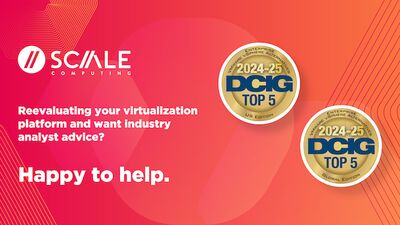
Scale Computing is a DCIG Top 5 Alternative to VMware vSphere
DCIG TOP 5 reports seek to help enterprises identify VMware vSphere alternatives. Download the 2024-2025 DCIG Top 5 VMware vSphere Alternatives reports. Get US and Global editions with insights on deployment options and migration tools.
Other hyperconverged platforms require so much extra maintenance, so having something simple that just works is a game changer. This means we can focus on other priorities and not have to worry about all the little details to keep other systems running properly.
Director of IT, Kingston Police
Mission-Critical IT for Mission-Critical Services: How the Kingston Police Modernized their IT Infrastructure with Scale Computing
The Kingston Police IT team wanted to modernize their existing VMware-based IT infrastructure, without breaking the bank. With officers and first responders dependent on access to real-time E911 data and applications, they needed a cost-effective solution that could work from day one.
Hardware Partners

Edge Computing Self-Assessment
We developed this Edge Computing Self-Assessment tool to help you think through the unique needs of your organization. While no assessment provides an exact formula, the personalized data our new tool offers can help you identify and explore your needs and preferences.
Platform//2024 Highlights
General
Scale Computing Product Roadmap
General
General
Customer Perspective: Implementing Scale Computing
General
Scale Computing HyperCore Resources
General
General
General
General
General
General
General
General
General
General
General
Related Resources
General
See What Others Have To Say About Scale Computing
We are proud to have over more than a thousand positive customer reviews on the most trusted third-party industry reviews websites. Read what our customers have to say on Gartner Peer Insights, G2, and TrustRadius.
